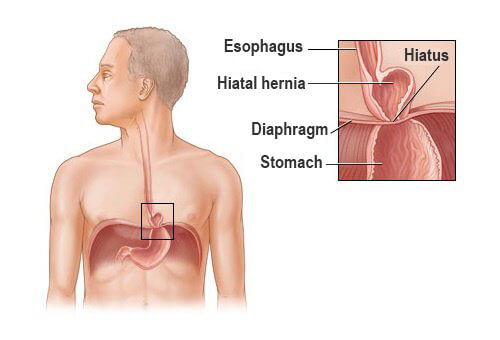Is it Possible to Treat a Hiatal Hernia?

A hiatal hernia happens when your stomach is forced to move, penetrating the chest cavity through an opening called a hiatus. The most common symptoms are heartburn, acid reflux, and pain or difficulty swallowing. Did you know that up to 20% of the population can get this disorder? More importantly, did you know that you can treat a hiatal hernia naturally with exercise and a good dit?
About hiatal hernias
Hiatal hernias can occur at any age, but they’re most common for people over the age of 50. There are several things that can lead to the weakening of the diaphragm that causes this disorder:
- Muscle weakness due to aging
- Chronic cough
- Constipation
- Obesity
- Stress
- Smoking
- Genetics
Read more: Discover 7 Simple Ways to Prevent Obesity
To treat this disorder naturally, you need to avoid those risk factors, along with following the tips in this article.
How do you treat a hiatal hernia?
To completely and effectively treat a hiatal hernia, you need to focus on two issues: the causes and the symptoms:
- Toning the weakened diaphragm muscle
- Getting relief from heartburn, gastroesophageal reflux, and pain and difficulty swallowing
Learning to eat correctly
One common thing that leads to a weakened hiatus might surprise you. Most people with a hiatal hernia share one thing in common: they eat without chewing their food properly, or chew too quickly. This puts added stress on the entire digestive system, and especially the stomach.
The first step is always to eat while sitting down, slowly, without distracting conversations, and without waiting until you’re absolutely starving. Also remember not to swallow your food until you’ve chewed it thoroughly.
This will also help avoid heartburn and gastroesophageal reflux.
Stimulate the diaphragm
It’s possible to tone the diaphragm muscle. Singers and people who engage in activities like yoga or other breathing techniques learn to control their breathing using their diaphragm. Instead of directing air to the upper part of the lungs, you have to try to fill your abdomen and the sides of your body.
It’s also good to get into the habit of taking short breaths after each meal, followed by pushing inward towards the diaphragm. This simple exercise is a great way to tone the diaphragm muscle and help treat a hiatal hernia.

Foods that can alleviate heartburn
Finally, to relieve symptoms like heartburn and acid reflux, you have to be careful with what you eat. Avoid acidic foods or anything else that just doesn’t sit well with you.
Generally avoid, or eat less of these things:
- Red meat and sausages
- Dairy
- Sugar
- Fried foods
- Processed foods and ingredients
- Baked goods
- Tobacco
- Alcohol
- Coffee
- Spices like cinnamon, cloves, ginger, and pepper
- Certain teas
- Fast food
Learn more: Effects of Alcohol in the Body

- Grapes: these are a very alkalizing fruit, just remember to look for organic ones to avoid pesticides.

- Pineapple: pineapple improves digestion thanks to its proteolytic enzymes. But you shouldn’t mix it with certain carbohydrates (breads, pasta, pastries, rice, etc.).
- Cabbage: cabbage helps heal ulcers, but there are many people who can’t digest it well raw. Cook it with a pinch of cumin, or try it raw, shredded cabbage with a vinaigrette dressing, or as sauerkraut.
- Peppers: peppers belong to the solanum family, which are excellent for healing the stomach.
- Potatoes: potatoes are a great natural antacid. Their juice is also a great way to counteract heartburn.
- Lemon juice: despite being a citrus (meaning it’s acidic), lemon has a neutralizing effect on stomach acids. This is why we recommend having it on a regular basis – with meals or just mixed into a little water.
- Millet: Millet is the only kind of grain that’s alkalizing, so it’s best to substitute it for other grains like rice, wheat, etc.
There are also oral tablets and pastes sold in herbal or dietary stores that work as natural antacids. Dissolve any one of these into a glass of water, and drink it after ten minutes.
All cited sources were thoroughly reviewed by our team to ensure their quality, reliability, currency, and validity. The bibliography of this article was considered reliable and of academic or scientific accuracy.
- Hyun, J. J., & Bak, Y.-T. (2011). Clinical Significance of Hiatal Hernia. Gut and Liver. https://doi.org/10.5009/gnl.2011.5.3.267
- Mitiek, M. O., & Andrade, R. S. (2010). Giant Hiatal Hernia. Annals of Thoracic Surgery. https://doi.org/10.1016/j.athoracsur.2010.03.022
- Peters, J. H. (2013). SAGES guidelines for the management of hiatal hernia. Surgical Endoscopy and Other Interventional Techniques. https://doi.org/10.1007/s00464-013-3212-0
This text is provided for informational purposes only and does not replace consultation with a professional. If in doubt, consult your specialist.








